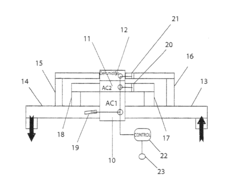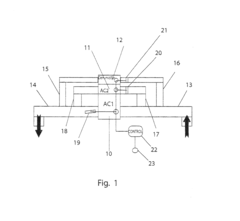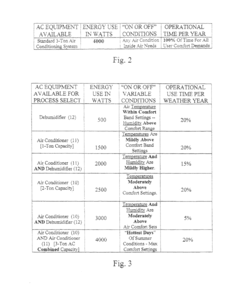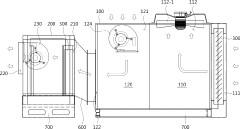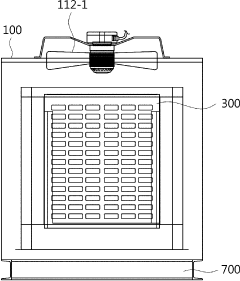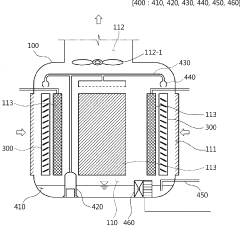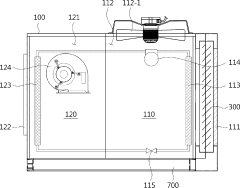Mild hybrid air conditioning systems and their energy efficiency
AUG 18, 20259 MIN READ
Generate Your Research Report Instantly with AI Agent
Patsnap Eureka helps you evaluate technical feasibility & market potential.
Mild Hybrid AC Background and Objectives
Mild hybrid air conditioning systems represent a significant advancement in automotive climate control technology, combining traditional vapor compression cycles with electric-driven components to enhance overall energy efficiency. This innovative approach has emerged as a response to the growing demand for more sustainable and fuel-efficient vehicles, particularly in the context of increasingly stringent environmental regulations worldwide.
The evolution of mild hybrid AC systems can be traced back to the early 2000s when automotive manufacturers began exploring ways to reduce the parasitic load of air conditioning on internal combustion engines. Traditional AC systems rely heavily on engine power, which can significantly impact fuel consumption, especially in stop-and-go traffic conditions. The introduction of mild hybrid technology offered a promising solution to this challenge by integrating electric motors and advanced control systems into the AC architecture.
The primary objective of researching mild hybrid AC systems is to develop more energy-efficient climate control solutions that can contribute to overall vehicle efficiency without compromising passenger comfort. This goal aligns with broader industry trends towards electrification and the reduction of greenhouse gas emissions in the transportation sector.
Key technological advancements in mild hybrid AC systems include the integration of electric compressors, which can operate independently of the engine, and the implementation of intelligent control algorithms that optimize system performance based on various factors such as vehicle speed, ambient temperature, and occupant preferences. These innovations allow for more precise temperature control and reduced energy consumption, particularly during engine-off periods in start-stop systems.
Another critical aspect of mild hybrid AC research is the exploration of alternative refrigerants with lower global warming potential (GWP). This focus is driven by environmental concerns and regulatory pressures to phase out high-GWP refrigerants such as R-134a. The development of compatible components and system designs for new refrigerants is an integral part of advancing mild hybrid AC technology.
The research landscape for mild hybrid AC systems encompasses a wide range of disciplines, including thermodynamics, electrical engineering, control systems, and materials science. Collaborative efforts between automotive manufacturers, suppliers, and research institutions have been instrumental in driving innovation in this field. These partnerships have led to the development of prototypes and concept vehicles that showcase the potential of mild hybrid AC technology to significantly reduce fuel consumption and emissions associated with vehicle climate control.
As the automotive industry continues its transition towards electrification, the role of mild hybrid AC systems is expected to evolve further. Future research directions may include the integration of these systems with other vehicle subsystems, such as battery thermal management in electric and plug-in hybrid vehicles, to achieve even greater overall energy efficiency gains.
The evolution of mild hybrid AC systems can be traced back to the early 2000s when automotive manufacturers began exploring ways to reduce the parasitic load of air conditioning on internal combustion engines. Traditional AC systems rely heavily on engine power, which can significantly impact fuel consumption, especially in stop-and-go traffic conditions. The introduction of mild hybrid technology offered a promising solution to this challenge by integrating electric motors and advanced control systems into the AC architecture.
The primary objective of researching mild hybrid AC systems is to develop more energy-efficient climate control solutions that can contribute to overall vehicle efficiency without compromising passenger comfort. This goal aligns with broader industry trends towards electrification and the reduction of greenhouse gas emissions in the transportation sector.
Key technological advancements in mild hybrid AC systems include the integration of electric compressors, which can operate independently of the engine, and the implementation of intelligent control algorithms that optimize system performance based on various factors such as vehicle speed, ambient temperature, and occupant preferences. These innovations allow for more precise temperature control and reduced energy consumption, particularly during engine-off periods in start-stop systems.
Another critical aspect of mild hybrid AC research is the exploration of alternative refrigerants with lower global warming potential (GWP). This focus is driven by environmental concerns and regulatory pressures to phase out high-GWP refrigerants such as R-134a. The development of compatible components and system designs for new refrigerants is an integral part of advancing mild hybrid AC technology.
The research landscape for mild hybrid AC systems encompasses a wide range of disciplines, including thermodynamics, electrical engineering, control systems, and materials science. Collaborative efforts between automotive manufacturers, suppliers, and research institutions have been instrumental in driving innovation in this field. These partnerships have led to the development of prototypes and concept vehicles that showcase the potential of mild hybrid AC technology to significantly reduce fuel consumption and emissions associated with vehicle climate control.
As the automotive industry continues its transition towards electrification, the role of mild hybrid AC systems is expected to evolve further. Future research directions may include the integration of these systems with other vehicle subsystems, such as battery thermal management in electric and plug-in hybrid vehicles, to achieve even greater overall energy efficiency gains.
Market Demand Analysis for Energy-Efficient HVAC
The market demand for energy-efficient HVAC systems, particularly mild hybrid air conditioning systems, has been steadily increasing in recent years. This growth is driven by several factors, including rising energy costs, stricter environmental regulations, and increasing awareness of sustainability issues among consumers and businesses.
In the residential sector, homeowners are increasingly seeking ways to reduce their energy bills while maintaining comfort. Mild hybrid air conditioning systems offer an attractive solution by combining traditional vapor compression technology with alternative cooling methods, such as evaporative cooling or desiccant dehumidification. This hybrid approach can significantly reduce energy consumption compared to conventional systems, making it appealing to cost-conscious consumers.
The commercial and industrial sectors also show strong demand for energy-efficient HVAC solutions. Large buildings, such as office complexes, shopping malls, and factories, consume substantial amounts of energy for cooling and heating. Facility managers and building owners are under pressure to reduce operating costs and meet sustainability targets. Mild hybrid air conditioning systems can help achieve these goals by optimizing energy use and reducing peak load demands.
The hospitality industry, including hotels and resorts, is another significant market for energy-efficient HVAC systems. These establishments often have high cooling requirements and are looking for ways to reduce their carbon footprint while maintaining guest comfort. Mild hybrid systems can provide a balance between energy efficiency and performance, making them an attractive option for this sector.
Government initiatives and regulations are also driving market demand for energy-efficient HVAC solutions. Many countries have implemented energy efficiency standards and building codes that require the use of more efficient cooling and heating systems. This regulatory push is creating opportunities for manufacturers and suppliers of mild hybrid air conditioning systems.
The global HVAC market is expected to continue growing, with energy-efficient systems playing a crucial role. Developing countries, particularly in Asia-Pacific and the Middle East, are experiencing rapid urbanization and increasing disposable incomes, leading to higher demand for air conditioning. These emerging markets present significant opportunities for energy-efficient HVAC technologies, including mild hybrid systems.
However, challenges remain in the widespread adoption of mild hybrid air conditioning systems. Initial costs can be higher than traditional systems, which may deter some potential customers. Additionally, there is a need for increased awareness and education about the long-term benefits and energy savings potential of these systems. Overcoming these barriers will be crucial for maximizing market penetration and realizing the full potential of mild hybrid air conditioning technology in improving overall HVAC energy efficiency.
In the residential sector, homeowners are increasingly seeking ways to reduce their energy bills while maintaining comfort. Mild hybrid air conditioning systems offer an attractive solution by combining traditional vapor compression technology with alternative cooling methods, such as evaporative cooling or desiccant dehumidification. This hybrid approach can significantly reduce energy consumption compared to conventional systems, making it appealing to cost-conscious consumers.
The commercial and industrial sectors also show strong demand for energy-efficient HVAC solutions. Large buildings, such as office complexes, shopping malls, and factories, consume substantial amounts of energy for cooling and heating. Facility managers and building owners are under pressure to reduce operating costs and meet sustainability targets. Mild hybrid air conditioning systems can help achieve these goals by optimizing energy use and reducing peak load demands.
The hospitality industry, including hotels and resorts, is another significant market for energy-efficient HVAC systems. These establishments often have high cooling requirements and are looking for ways to reduce their carbon footprint while maintaining guest comfort. Mild hybrid systems can provide a balance between energy efficiency and performance, making them an attractive option for this sector.
Government initiatives and regulations are also driving market demand for energy-efficient HVAC solutions. Many countries have implemented energy efficiency standards and building codes that require the use of more efficient cooling and heating systems. This regulatory push is creating opportunities for manufacturers and suppliers of mild hybrid air conditioning systems.
The global HVAC market is expected to continue growing, with energy-efficient systems playing a crucial role. Developing countries, particularly in Asia-Pacific and the Middle East, are experiencing rapid urbanization and increasing disposable incomes, leading to higher demand for air conditioning. These emerging markets present significant opportunities for energy-efficient HVAC technologies, including mild hybrid systems.
However, challenges remain in the widespread adoption of mild hybrid air conditioning systems. Initial costs can be higher than traditional systems, which may deter some potential customers. Additionally, there is a need for increased awareness and education about the long-term benefits and energy savings potential of these systems. Overcoming these barriers will be crucial for maximizing market penetration and realizing the full potential of mild hybrid air conditioning technology in improving overall HVAC energy efficiency.
Current State and Challenges in Mild Hybrid AC
Mild hybrid air conditioning systems have gained significant attention in recent years due to their potential for improving energy efficiency in vehicles. The current state of these systems reflects a balance between technological advancements and practical implementation challenges.
One of the primary developments in mild hybrid AC systems is the integration of electric compressors alongside traditional belt-driven compressors. This dual-compressor setup allows for more flexible operation, with the electric compressor providing cooling during engine-off periods and assisting the belt-driven compressor during high-load conditions. However, the integration of these systems presents challenges in terms of control strategies and power management.
Energy recovery is another key aspect of current mild hybrid AC systems. Regenerative braking and other energy recuperation techniques are being utilized to capture and store energy that would otherwise be lost, which can then be used to power the electric compressor or other auxiliary systems. While this approach shows promise for improving overall vehicle efficiency, it requires sophisticated energy management systems and adds complexity to the vehicle's electrical architecture.
Weight reduction and component optimization remain ongoing challenges in the development of mild hybrid AC systems. Engineers are working to minimize the additional weight introduced by hybrid components while maintaining or improving cooling performance. This often involves the use of advanced materials and compact designs, which can increase manufacturing costs and complexity.
Another significant challenge is the need for advanced control algorithms to manage the interplay between the electric and mechanical components of the AC system. These algorithms must optimize energy usage, maintain passenger comfort, and adapt to various driving conditions. The development of robust, efficient control strategies is crucial for maximizing the benefits of mild hybrid AC systems.
Thermal management is a critical area of focus, particularly in the context of electric component cooling and battery temperature regulation in mild hybrid vehicles. Integrating the AC system with the overall thermal management strategy of the vehicle presents both opportunities for efficiency gains and challenges in system design and operation.
Standardization and regulatory compliance pose additional challenges for mild hybrid AC systems. As regulations regarding vehicle emissions and energy efficiency become more stringent, manufacturers must ensure that their systems meet or exceed these requirements while remaining cost-effective and reliable.
Lastly, the automotive industry faces the challenge of balancing the cost of implementing mild hybrid AC systems against the potential fuel savings and environmental benefits. While these systems offer improved efficiency, the initial cost and complexity may be barriers to widespread adoption, particularly in lower-priced vehicle segments.
One of the primary developments in mild hybrid AC systems is the integration of electric compressors alongside traditional belt-driven compressors. This dual-compressor setup allows for more flexible operation, with the electric compressor providing cooling during engine-off periods and assisting the belt-driven compressor during high-load conditions. However, the integration of these systems presents challenges in terms of control strategies and power management.
Energy recovery is another key aspect of current mild hybrid AC systems. Regenerative braking and other energy recuperation techniques are being utilized to capture and store energy that would otherwise be lost, which can then be used to power the electric compressor or other auxiliary systems. While this approach shows promise for improving overall vehicle efficiency, it requires sophisticated energy management systems and adds complexity to the vehicle's electrical architecture.
Weight reduction and component optimization remain ongoing challenges in the development of mild hybrid AC systems. Engineers are working to minimize the additional weight introduced by hybrid components while maintaining or improving cooling performance. This often involves the use of advanced materials and compact designs, which can increase manufacturing costs and complexity.
Another significant challenge is the need for advanced control algorithms to manage the interplay between the electric and mechanical components of the AC system. These algorithms must optimize energy usage, maintain passenger comfort, and adapt to various driving conditions. The development of robust, efficient control strategies is crucial for maximizing the benefits of mild hybrid AC systems.
Thermal management is a critical area of focus, particularly in the context of electric component cooling and battery temperature regulation in mild hybrid vehicles. Integrating the AC system with the overall thermal management strategy of the vehicle presents both opportunities for efficiency gains and challenges in system design and operation.
Standardization and regulatory compliance pose additional challenges for mild hybrid AC systems. As regulations regarding vehicle emissions and energy efficiency become more stringent, manufacturers must ensure that their systems meet or exceed these requirements while remaining cost-effective and reliable.
Lastly, the automotive industry faces the challenge of balancing the cost of implementing mild hybrid AC systems against the potential fuel savings and environmental benefits. While these systems offer improved efficiency, the initial cost and complexity may be barriers to widespread adoption, particularly in lower-priced vehicle segments.
Existing Mild Hybrid AC Solutions
01 Hybrid compressor systems for improved efficiency
Mild hybrid air conditioning systems utilize hybrid compressor configurations that combine electric and mechanical drive mechanisms. This approach allows for optimal energy management, reducing the load on the vehicle's engine and improving overall system efficiency. The hybrid compressor can operate in various modes depending on driving conditions and cooling demands.- Hybrid compressor systems for improved efficiency: Mild hybrid air conditioning systems utilize hybrid compressor configurations that combine electric and mechanical power sources. This approach allows for optimized operation based on driving conditions, reducing overall energy consumption. The system can switch between electric and mechanical power, or use both simultaneously, to maximize efficiency and reduce the load on the vehicle's engine.
- Energy recovery and storage in mild hybrid AC systems: These systems incorporate energy recovery mechanisms to capture and store energy during vehicle deceleration or braking. The recovered energy is then used to power the air conditioning system, reducing the load on the main power source. This approach significantly improves overall energy efficiency and reduces fuel consumption in vehicles equipped with mild hybrid air conditioning systems.
- Intelligent control strategies for energy optimization: Advanced control algorithms and strategies are employed to optimize the operation of mild hybrid air conditioning systems. These intelligent control systems consider factors such as cabin temperature, ambient conditions, and vehicle operating state to adjust compressor speed, refrigerant flow, and power source selection. By continuously optimizing system parameters, energy efficiency is maximized while maintaining desired comfort levels.
- Integration with vehicle thermal management systems: Mild hybrid air conditioning systems are integrated with overall vehicle thermal management systems to achieve synergistic energy savings. This integration allows for efficient heat exchange between various vehicle subsystems, such as the engine cooling system, battery thermal management, and cabin climate control. By optimizing heat transfer and utilization across these systems, overall energy efficiency is improved.
- Variable refrigerant flow and multi-evaporator systems: Advanced mild hybrid air conditioning systems utilize variable refrigerant flow technologies and multi-evaporator configurations. These designs allow for precise control of cooling capacity in different zones of the vehicle, reducing energy waste. By adjusting refrigerant flow and evaporator operation based on specific cooling needs, the system achieves higher energy efficiency while maintaining optimal comfort levels throughout the vehicle cabin.
02 Energy recovery and storage in mild hybrid AC systems
These systems incorporate energy recovery mechanisms to capture and store energy during vehicle deceleration or braking. The recovered energy is then used to power the air conditioning system, reducing the reliance on the engine and improving overall energy efficiency. This approach often involves the use of advanced battery systems or supercapacitors for energy storage.Expand Specific Solutions03 Intelligent control strategies for optimized performance
Mild hybrid air conditioning systems employ sophisticated control algorithms to optimize system performance. These strategies consider factors such as vehicle speed, ambient temperature, and passenger comfort requirements to adjust compressor operation, refrigerant flow, and energy distribution. The intelligent control helps maintain comfort while minimizing energy consumption.Expand Specific Solutions04 Integration with vehicle thermal management systems
Advanced mild hybrid air conditioning systems are integrated with the vehicle's overall thermal management system. This integration allows for better coordination between the air conditioning, engine cooling, and battery thermal management, leading to improved energy efficiency across all systems. Heat exchange between different components is optimized to reduce waste and improve overall performance.Expand Specific Solutions05 Use of alternative refrigerants and eco-friendly technologies
To further enhance energy efficiency and reduce environmental impact, mild hybrid air conditioning systems often incorporate alternative refrigerants with lower global warming potential. Additionally, these systems may use eco-friendly technologies such as magnetic refrigeration or thermoelectric cooling to complement or replace traditional vapor compression cycles, resulting in improved overall system efficiency.Expand Specific Solutions
Key Players in Mild Hybrid AC Industry
The research on mild hybrid air conditioning systems and their energy efficiency is in a developing stage, with growing market potential due to increasing focus on energy efficiency and environmental concerns. The technology is advancing, but not yet fully mature. Key players like Carrier Corp., Hyundai Motor Co., and Daikin Industries are investing in R&D to improve system performance. Automotive companies such as Audi AG, Mercedes-Benz Group, and BYD Co. are integrating these systems into their vehicles to meet stricter emissions standards. The market is expected to grow as regulations tighten and consumer demand for more efficient HVAC solutions increases, particularly in the automotive and building sectors.
Carrier Corp.
Technical Solution: Carrier Corp. has developed an advanced mild hybrid air conditioning system that integrates a compact electric compressor with a traditional belt-driven compressor. This system utilizes intelligent control algorithms to optimize the operation between electric and mechanical compressors based on driving conditions and cooling demands. The electric compressor operates during engine-off periods, such as start-stop events, providing continuous cooling without engine dependency. During normal driving, the system seamlessly switches to the belt-driven compressor for efficient operation. Carrier's system also incorporates a high-efficiency heat exchanger and variable-speed fans to further enhance energy efficiency[1][3]. The company has reported up to 20% improvement in fuel economy and a significant reduction in CO2 emissions compared to conventional AC systems[2].
Strengths: Seamless integration of electric and mechanical compressors, continuous cooling during engine-off periods, improved fuel economy. Weaknesses: Potentially higher initial cost, complexity in system integration and control.
Hyundai Motor Co., Ltd.
Technical Solution: Hyundai has developed a mild hybrid air conditioning system that utilizes a 48V electrical system. Their approach combines a belt-driven compressor with an electric compressor, allowing for efficient operation in various driving modes. The system employs advanced thermal management strategies, including the use of phase-change materials for thermal energy storage. This enables the air conditioning to operate efficiently during engine-off periods and quick restarts. Hyundai's system also incorporates a smart control unit that predicts cooling demands based on factors such as vehicle speed, ambient temperature, and occupant preferences[4]. The company has reported energy efficiency improvements of up to 15% in real-world driving conditions, with the most significant gains observed in urban stop-and-go traffic[5].
Strengths: Integration with 48V electrical system, thermal energy storage for improved efficiency, predictive control for optimized performance. Weaknesses: Dependency on 48V system adoption, potential increase in vehicle complexity and weight.
Core Innovations in Energy-Efficient AC
Hybrid air conditioning system
PatentInactiveUS20140231063A1
Innovation
- A hybrid air conditioning system comprising multiple independently operable units of varying capacities and a dehumidifier, controlled by sensors and a process controller to match specific air treatment needs, allowing for efficient temperature and humidity regulation while minimizing energy use.
Hybrid air conditioning system
PatentActiveKR1020190115858A
Innovation
- A hybrid air conditioning system combining a cooling pad system with an evaporator, using evaporative cooling and a condensing unit, with adjustable operation based on climate conditions, and detachable cooling pads to enhance efficiency and reduce maintenance.
Environmental Impact of Mild Hybrid AC Systems
Mild hybrid air conditioning systems have emerged as a promising solution to reduce the environmental impact of vehicle climate control. These systems integrate electric components with traditional vapor compression cycles, offering significant improvements in energy efficiency and emissions reduction.
The primary environmental benefit of mild hybrid AC systems lies in their ability to reduce fuel consumption and, consequently, greenhouse gas emissions. By utilizing electric power for certain operations, such as running the compressor during idle periods or assisting during high-load conditions, these systems can decrease the engine's workload. This reduction in engine load translates to lower fuel consumption, with studies indicating potential fuel savings of up to 5-10% in urban driving conditions.
Carbon dioxide emissions, a major contributor to global warming, are directly correlated with fuel consumption in internal combustion engines. As mild hybrid AC systems reduce fuel usage, they consequently lower CO2 emissions. Estimates suggest that widespread adoption of these systems could lead to a substantial decrease in automotive CO2 emissions, potentially contributing to global climate change mitigation efforts.
Another environmental advantage of mild hybrid AC systems is their potential to use more environmentally friendly refrigerants. As these systems often incorporate advanced control strategies and components, they can be designed to work efficiently with low Global Warming Potential (GWP) refrigerants, such as R-1234yf or CO2 (R-744). This transition to less harmful refrigerants further reduces the overall environmental impact of vehicle air conditioning.
Mild hybrid AC systems also contribute to reducing other harmful emissions, such as nitrogen oxides (NOx) and particulate matter. By decreasing the load on the engine, especially during idle and low-speed operations where emissions are typically higher, these systems help vehicles meet increasingly stringent emission standards.
The environmental benefits extend beyond direct emissions. Mild hybrid AC systems can potentially increase the lifespan of engine components by reducing their workload, leading to less frequent replacements and, consequently, lower resource consumption and waste generation associated with manufacturing and disposing of these parts.
However, it's important to consider the full lifecycle environmental impact of mild hybrid AC systems. While they offer significant benefits during operation, the production of additional electric components and batteries may have environmental costs. Manufacturers must balance these factors through sustainable production practices and end-of-life recycling programs to maximize the net positive environmental impact of these systems.
The primary environmental benefit of mild hybrid AC systems lies in their ability to reduce fuel consumption and, consequently, greenhouse gas emissions. By utilizing electric power for certain operations, such as running the compressor during idle periods or assisting during high-load conditions, these systems can decrease the engine's workload. This reduction in engine load translates to lower fuel consumption, with studies indicating potential fuel savings of up to 5-10% in urban driving conditions.
Carbon dioxide emissions, a major contributor to global warming, are directly correlated with fuel consumption in internal combustion engines. As mild hybrid AC systems reduce fuel usage, they consequently lower CO2 emissions. Estimates suggest that widespread adoption of these systems could lead to a substantial decrease in automotive CO2 emissions, potentially contributing to global climate change mitigation efforts.
Another environmental advantage of mild hybrid AC systems is their potential to use more environmentally friendly refrigerants. As these systems often incorporate advanced control strategies and components, they can be designed to work efficiently with low Global Warming Potential (GWP) refrigerants, such as R-1234yf or CO2 (R-744). This transition to less harmful refrigerants further reduces the overall environmental impact of vehicle air conditioning.
Mild hybrid AC systems also contribute to reducing other harmful emissions, such as nitrogen oxides (NOx) and particulate matter. By decreasing the load on the engine, especially during idle and low-speed operations where emissions are typically higher, these systems help vehicles meet increasingly stringent emission standards.
The environmental benefits extend beyond direct emissions. Mild hybrid AC systems can potentially increase the lifespan of engine components by reducing their workload, leading to less frequent replacements and, consequently, lower resource consumption and waste generation associated with manufacturing and disposing of these parts.
However, it's important to consider the full lifecycle environmental impact of mild hybrid AC systems. While they offer significant benefits during operation, the production of additional electric components and batteries may have environmental costs. Manufacturers must balance these factors through sustainable production practices and end-of-life recycling programs to maximize the net positive environmental impact of these systems.
Cost-Benefit Analysis of Mild Hybrid AC Implementation
The implementation of mild hybrid air conditioning systems presents a complex cost-benefit scenario for automotive manufacturers and consumers alike. Initial investment costs for mild hybrid AC systems are typically higher than traditional systems due to the integration of advanced components such as electric compressors and battery systems. However, these upfront costs must be weighed against long-term operational savings and environmental benefits.
From a manufacturer's perspective, the primary cost considerations include research and development, retooling production lines, and potentially higher component costs. These expenses can be significant, especially for automakers transitioning their entire product line to mild hybrid technology. However, economies of scale and technological advancements are expected to gradually reduce production costs over time.
For consumers, the increased vehicle purchase price is offset by reduced fuel consumption and lower maintenance costs. Mild hybrid AC systems can improve fuel efficiency by 5-10% in urban driving conditions, where stop-start technology is most effective. This translates to substantial fuel savings over the vehicle's lifetime, particularly in regions with high fuel prices or heavy traffic congestion.
Maintenance costs for mild hybrid AC systems may initially be higher due to the complexity of the technology and the need for specialized technicians. However, as the technology becomes more widespread, these costs are expected to normalize. Additionally, the reduced wear on engine components due to less frequent idling can lead to longer-term savings on engine maintenance.
Environmental benefits, while not directly quantifiable in monetary terms, contribute significantly to the overall value proposition. Reduced fuel consumption leads to lower greenhouse gas emissions, aligning with increasingly stringent environmental regulations and consumer preferences for eco-friendly vehicles. This can enhance brand reputation and potentially increase market share for manufacturers adopting the technology.
Government incentives and regulations play a crucial role in the cost-benefit analysis. Many countries offer tax credits, rebates, or other financial incentives for vehicles with improved fuel efficiency, which can help offset the higher initial costs for both manufacturers and consumers. Stricter emissions standards also push manufacturers towards adopting more efficient technologies, making mild hybrid AC systems an attractive option for compliance.
In conclusion, while the upfront costs of implementing mild hybrid AC systems are substantial, the long-term benefits in terms of fuel savings, reduced emissions, and potential regulatory compliance make a compelling case for their adoption. As technology advances and production scales up, the cost-benefit ratio is expected to improve further, potentially making mild hybrid AC systems a standard feature in future vehicle models.
From a manufacturer's perspective, the primary cost considerations include research and development, retooling production lines, and potentially higher component costs. These expenses can be significant, especially for automakers transitioning their entire product line to mild hybrid technology. However, economies of scale and technological advancements are expected to gradually reduce production costs over time.
For consumers, the increased vehicle purchase price is offset by reduced fuel consumption and lower maintenance costs. Mild hybrid AC systems can improve fuel efficiency by 5-10% in urban driving conditions, where stop-start technology is most effective. This translates to substantial fuel savings over the vehicle's lifetime, particularly in regions with high fuel prices or heavy traffic congestion.
Maintenance costs for mild hybrid AC systems may initially be higher due to the complexity of the technology and the need for specialized technicians. However, as the technology becomes more widespread, these costs are expected to normalize. Additionally, the reduced wear on engine components due to less frequent idling can lead to longer-term savings on engine maintenance.
Environmental benefits, while not directly quantifiable in monetary terms, contribute significantly to the overall value proposition. Reduced fuel consumption leads to lower greenhouse gas emissions, aligning with increasingly stringent environmental regulations and consumer preferences for eco-friendly vehicles. This can enhance brand reputation and potentially increase market share for manufacturers adopting the technology.
Government incentives and regulations play a crucial role in the cost-benefit analysis. Many countries offer tax credits, rebates, or other financial incentives for vehicles with improved fuel efficiency, which can help offset the higher initial costs for both manufacturers and consumers. Stricter emissions standards also push manufacturers towards adopting more efficient technologies, making mild hybrid AC systems an attractive option for compliance.
In conclusion, while the upfront costs of implementing mild hybrid AC systems are substantial, the long-term benefits in terms of fuel savings, reduced emissions, and potential regulatory compliance make a compelling case for their adoption. As technology advances and production scales up, the cost-benefit ratio is expected to improve further, potentially making mild hybrid AC systems a standard feature in future vehicle models.
Unlock deeper insights with Patsnap Eureka Quick Research — get a full tech report to explore trends and direct your research. Try now!
Generate Your Research Report Instantly with AI Agent
Supercharge your innovation with Patsnap Eureka AI Agent Platform!
